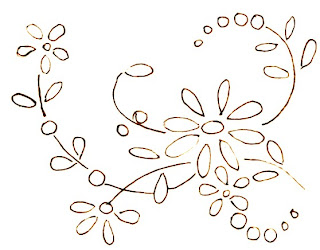It's hard to know how to label these posts so that you can follow the progression. Just look for "Whole Cloth Crazy Quilt" in the list to the right to see different aspects. I have put Part 2, 3, etc. to show you the order to follow. I work on so many things during a week, back and forth, back and forth, I get overwhelmed sometimes with the ideas swirling around in my head. Sick, sick, sick!!
Painting on crazy quilts: Many of the oldest crazy quilts I've seen have some motifs that are colored by painting. I've tried many of the ones on the market today in very small areas on some of my projects. Most of them work ok but running can be a problem when working with some of them. Who wants to spend hours piecing and then lose control of a liquid paint?!
Last year I purchased several colors of the Shiva paintsticks. These are oil paint in a solid form and are in the shape of a really fat crayon. They have a film that forms over them that has to be removed every time you use them, but serves to protect them from completely drying out in between uses. They are meant to last for years. I was not having a lot of luck with them as there are very few instructions available except for using the large templates that you can buy to make overall designs on fabrics. This was not up my alley. The paint is in a solid form so finding brushes with stiff enough bristles is not easy. I even used the smallest size stencil brush I could find - too big!
Before I continue, here is some Important Information you should have before you paint. Always try the paint on a scrap of the fabric you are going to be using in your finished project. The paint works better on some fabrics than it does on others. You can paint most fabrics but it's the density of color that is the problem (for me anyway.) Sometimes all you need to do is change the color to get a good result.
My first try: A couple of my friends and I did some experimenting with the paints recently and have found a technique that we thought was super easy. Got cheap toothpicks???!!! The ones with the flat end work. Just take a little paint on a toothpick, set it on the area you want to cover, use the flat end of the toothpick, and spread the paint out. Then you can use a regular brush to smooth over the area.
Here are photos of two motifs and a fan I used paint sticks on along with a line drawing of each for you to use as desired.
Motif 1) I used a backstitch to outline this butterfly in gold metallic thread and added a little red metallic thread to the inside of the wings to set apart some areas. Then I painted inside the red areas with metallic gold Shiva. I will add beads later.


Motif 2) I used the outline stitch to make the flower and was going to use satin stitch on it. The Shiva paint was easier and quicker. I used three colors in the leaves including gold to highlight them and pink paint with red on top for the petals. The two colors blended together nicely by rubbing the red into the pink with the flat end of a toothpick. I will add a few beads later.


My large fan) Here is a series of photos showing the fan that I designed for my wallhanging. Trying to find a picture of cherry blossoms I thought I could use (which I felt I absolutely had to have) was not as easy as I thought it would be. I finally bought a book with royalty free drawings and changed it to fit my fan area. I'm pretty good at drawing simple things but surely am not an artist. I used transfer paper to trace it onto my fabric which is a black synthetic material with a smooth and shiny surface. Painting turned out to be easier this time (I think it was because of the smooth surface.) Because the area was so large, I probably would have given up easily if it had not been. This time, I used a palette knife and shaved the paints off onto a glass plate and mashed and mixed until the paint was smooth. I mixed in a colorless blender (also available as a Shiva paint stick) whenever I wanted to mix two colors together. I used a small stencil prush and a regular paint brush (for smaller areas) to apply the paint. It came out a lot lighter than I was aiming for but I really like the result. I will have to see it actually on my wallhanging before I decide if it will stay, however. The threads used in the wallhanging are very vibrant and this fan may have to be redone so that it looks right. This fan "saga" may not be over - we'll see!! I am going to use a twin needle with black thread to make the "veins" for the fan.


There are so many places selling these paint sticks at discounts online that I don't find it worth my while to stock them. Buy some and give it a try. It's really a lot of fun!










































